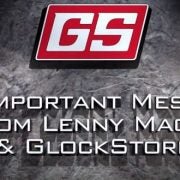
The anti-gunners want to believe this time will be different. In truth, they might be right. Politicians are notoriously wishy-washy when it comes to polling numbers, and many polls seem to be showing broad support for gun control measures, at least in part. It’s not hard to imagine that gun rights are in real jeopardy this time.
However, let’s also be realistic. This particular gun control movement isn’t any different, despite what some people may try and claim (via The Christian Century).
When Sam Zeif met with President Trump after the mass shooting at his high school in Parkland, Florida, he broke down in frustration and tears. “How have we not stopped this?” he asked. “After Columbine? After Sandy Hook?”
Zeif’s outrage is understandable. It’s also easy to understand those who have become cynical about political leaders’ persistent unwillingness to tackle gun violence. More than 200 school shootings have taken place since the murders at Columbine, Colorado, in 1999. About 39,000 gun deaths happen each year in the United States. Legislators have mourned but done nothing to address the problem. No meaningful gun control legislation has been passed at the federal level since 1994, when a ban on certain semiautomatic weapons was tucked into the crime bill. That ban expired in 2004.
A couple of points.
First, of those 39,000 deaths, two-thirds are suicides. That tends to be left out when that number is mentioned, and it’s important. Most people understand that you won’t stop suicides by banning the tools people use to commit suicide. If you do that, you’ll eventually have to ban gravity as well. Most of that number is the result of people making a decision and acting on that decision, often without hurting anyone else. Let’s keep that in mind.
Second, since they brought up the assault weapon ban from 1994, it should also be noted that crime was trending downward before the law was passed and continued downward since the law sunset. In other words, the law had no appreciable impact on crime. Imagine that.
Additionally, a red wave overtook Congress following that bill’s passage, which made even Democrats wary of passing gun control legislation.
But the hundreds of thousands of people who gathered at March for Our Lives rallies in late March offered hope that a new movement is under way, led by teens who have seen the trauma of gun violence firsthand and say: no more. What’s hopeful about the latest movement, besides the refreshing leadership of uncynical students, is how it has avoided some of the patterns that have paralyzed previous efforts.
If by “refreshing leadership of uncynical students,” you mean leadership funded by astroturf movements and consisting of foul-mouthed and uninformed individuals, then sure. It’s refreshing.
To start with, the student-led movement has recognized that gun violence affects everyone; it is an issue for people of all races and places. It is an issue that should unite Americans, not divide them.
In her speech at the rally in Washington, 17-year-old Jaclyn Corin acknowledged the racial divide that has to be overcome on this issue. In 2012, black teenagers occupied Florida’s state capitol to protest the shooting of black teenager Trayvon Martin—without getting the kind of attention the Parkland survivors are getting. “But we share this stage today and forever with those communities who have always stared down the barrel of a gun,” said Corin. Edna Chavez, a student from South Los Angeles, was one of the speakers at the Washington rally. “I learned to duck from bullets before I learned to read,” she said.
When are these people going to stop pretending that gun violence is somehow worse than any other form of violence? If your loved one is killed, it doesn’t matter if it was done with a gun or a knife, they’re just as dead. A gun is a tool, but it’s also a tool that is used to save far more lives than take them.
The real problem is violence, plain and simple. Taking away a tool doesn’t make violence go down. In fact, it increases. Take London, for example. England has strict gun control measures, measures that would never fly in the United States even in this current environment. Now London has a higher murder rate than New York City.
If you’re serious about stopping violence, you need to find out why people are violent in the first place. Refusing to start there just shows us you’re not serious about the issue.
The movement also has avoided partisan politics. “This isn’t about the GOP. This isn’t about the Democrats,” said student Cameron Kasky. “This is about us creating a badge of shame for any politicians who are accepting money from the [National Rifle Association] and using us as collateral.” Judging from past failures at gun control, effective strategies and rhetoric will be issue-oriented, not party-oriented.
Yes, Kasky said that.
But the March for Our Lives also featured a lot of bashing of the Republican Party. Marco Rubio has been a repeated target of David Hogg’s, as well as the target of ire for many of the movement’s followers. A look at the signs at the walkouts and the marches show just how wrong this claim is.
Donald Trump called Hogg, Kasky’s fellow traveler, in hopes of having a thoughtful discussion, and Hogg bragged about hanging up on the man. Here he is, the President of the United States, someone who you have to get on your side if you want national level gun control, and Hogg hangs up on him. Why? Because bashing Trump is cool.
But yeah, totally non-partisan.
Third, the movement has focused on electoral process. It has called on young people to register to vote and to hold candidates accountable. “We are going to take this to every election, to every state and every city,” said Parkland student David Hogg. “When politicians send their thoughts and prayers with no action, we say no more.”
And will they?
See, everyone knows that democracy belongs to those who show up. This isn’t new, and the strategy isn’t new. There’s a reason why so many movements also try to include voter registration drives.
But the March for Our Lives only included a very vocal subsection of American youth. There were many more who never showed up at a march. Still, others are rallying in support of the Second Amendment, because even people who don’t own guns can see that taking away our rights in such a way could have horrible ramifications.
However, let’s not kid ourselves; this movement isn’t any different than the ones in the past. It’s the same movement with many of the same people involved behind the scenes. It has a few new, young faces, but they’re spouting the same old lines. Claims of non-partisanship are lies designed to mislead people who won’t look for themselves, hoping the animosities of the past aren’t noticed this time around.
But all this is, in reality, the same old gun control movement dressed up in a shiny new outfit. It’s the same tactics, the same bogus statistics, and the same rhetoric.
Anyone who claims otherwise is either delusional or a liar.
The post No Amount Of Spin Will Make This Gun Control Movement Different appeared first on Bearing Arms.
via Bearing Arms
No Amount Of Spin Will Make This Gun Control Movement Different
 Miriam Bowers Abbott
Miriam Bowers Abbott 























 Lenny Magill, the owner and CEO of GlockStore.com, has recently published a video announcement addressing the new YouTube strict policies regarding firearm-related content. He has created a new website (GunVideo.com) to have a safe platform for hosting their videos and which may also become a video sharing platform for other content creators in the industry. Glock […]
Lenny Magill, the owner and CEO of GlockStore.com, has recently published a video announcement addressing the new YouTube strict policies regarding firearm-related content. He has created a new website (GunVideo.com) to have a safe platform for hosting their videos and which may also become a video sharing platform for other content creators in the industry. Glock […]

